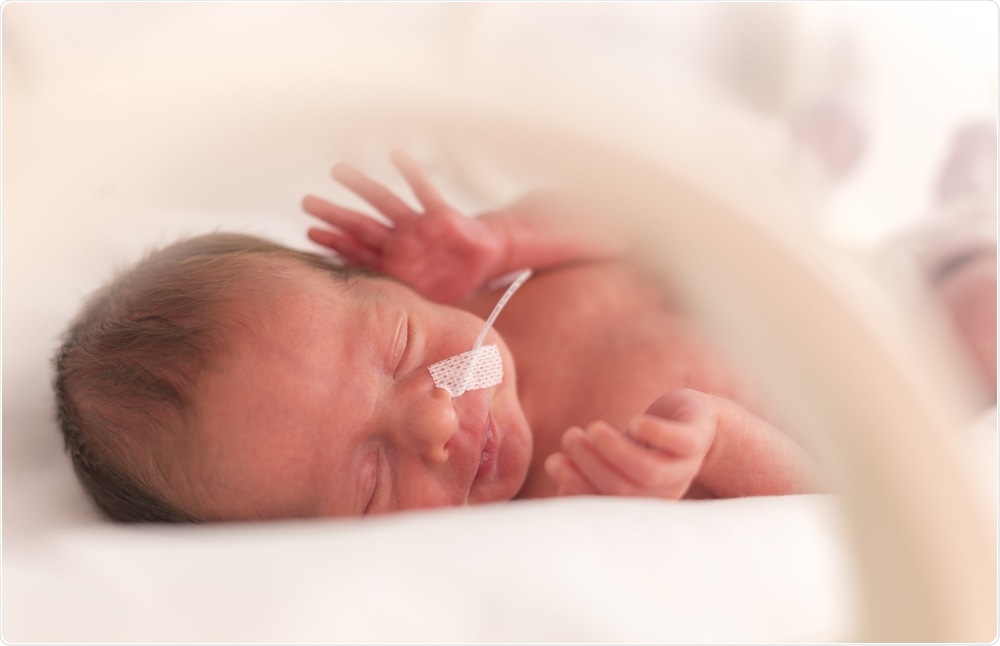One in 10 babies are born prematurely in the United States, leading to complications that can impact the infants’ locomotor development and affect basic tasks, like standing, walking, and balance later in their life.

Premature Baby. Image Credit: OndroM/Shutterstock.com
A recent peer-reviewed study performed by Children’s National Hospital has precisely investigated which neural circuitry of the cerebellum is influenced by these complications that manifest around the time of birth and lead to these learning deficits, and has eventually identified a certain type of neurons, called Purkinje cells, to play a crucial role.
The study was published in the Proceedings of the National Academy of Sciences of the United States of America (PNAS).
To date, only limited techniques are available to determine the activity of neurons during the locomotor learning tasks that involve the cerebellum. To overcome this problem, Children’s National Hospital has adopted a multidisciplinary strategy, in which a group of neonatologists and neuroscientists has exploited their collective know-how to develop a unique and novel way to determine the real-time activity of Purkinje cells in a pre-clinical model that has relevance to human beings.
First, the function of neural circuits was measured by coupling GCaMP6f fiber photometry—used for measuring the brain’s neuronal activity of a free-moving subject—with an ErasmusLadder, wherein it has to move from points A to B on a horizontal ladder with touch-responsive rungs that record the length and type of steps.
When the researchers introduced an unexpected obstacle to this movement, they noticed how the subject handled this obstacle and learned accordingly to prevent it. When the researchers played a high-pitched tone just before introducing the obstacle, they were able to determine the speed at which subjects can rapidly expect the obstacle and modify their steps accordingly.
Normal models and subjects with neonatal brain injury were run through a range of learning trials while their brain activity was monitored concurrently. In this manner, the researchers were able to measure the cerebellum-dependent adaptive behavior and locomotor learning, revealing a mechanistic and functional interpretation of behavioral pathology that was not observed in this field before.
With this technology, we are able to understand the response of specific cells to external stimuli. Our findings honed in on Purkinje cell activity for this experiment. But extrapolating further, we can use this technology in the clinic, applying cell-specific stimulations or drugs to understand if each has a protective or harming effect in the brain.”
Vittorio Gallo, PhD, Study Lead Author and Chief Research Officer, Children’s National Hospital
Apart from demonstrating that normal Purkinje cells are extremely active when moving on the ErasmusLadder, the researchers analyzed the question of whether Purkinje cells of impaired pre-clinical models were normally non-responsive to any type of stimuli.
The team observed that while the Purkinje cells in impaired subjects reacted to puffs of air, which usually signal the subject to start moving on the ErasmusLadder, dysfunction in the Purkinje cells was specific to the time of adaptive learning.
Last but not the least, through chemogenetic inhibition, which particularly silences the activity of neonatal Purkinje cells, the researchers were able to simulate the impacts of the perinatal cerebellar injury, additionally reinforcing the role of the Purkinje cells in learning deficits.
“Research to date has focused on damage to the cerebral cortex as the cause of learning deficits,” stated Mark Batshaw, M.D, executive vice president, physician-in-chief, chief academic officer, and director of Children’s National Research Institute. Dr. Batshaw was not involved in the study.
“Dr. Gallo’s lab has been at the forefront in understanding how the cerebellum, in addition to the cortex, is an important contributor to altering normal brain development in premature babies, placing them at greater risk for disabilities. These seminal contributions are critical to understanding how we can improve care to these fragile infants in early life and protect their brain,” added Dr. Batshaw.
A deeper understanding of the connection between brain injury, Purkinje cell development and circuitry could allow for opportunities to explore better targeting of pharmacological approaches. Certain targeted drugs could provide added protection to Purkinje cells, mitigating the effects of brain injury on locomotor development following preterm births.”
Aaron Sathyanesan, PhD, Study First Author and Research Faculty, Children’s National Hospital
The results of the study hold implications for clinical practice. As the care of preterm infants continues to enhance, neonatologists face new difficulties to make sure that infants not only live but also thrive. These experts have to identify ways to prevent the lifelong effects of preterm birth on the cerebellum and thus, the developing brain.
Reflecting further on the upcoming implications of this study, neonatologist and the study author, Panagiotis Kratimenos, MD, Ph.D., stated: “With the new generation of extremely preterm babies, more sophisticated methods are essential for protecting their brains.”
The more we understand regarding these mechanisms, the more we’ll be able to help premature babies grow into teenagers and adults with the ability to live a functional life.”
Panagiotis Kratimenos, MD, PhD, Study Author and Neonatologist, Children’s National Hospital